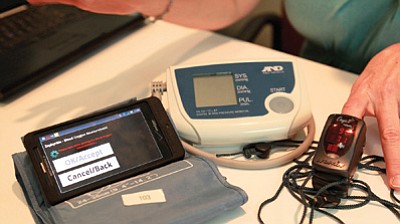Flagstaff Medical Center expands Telehealth program
Hospital specialists can now consult at more locations across Navajo Reservation, program hopes to keep more patients at home and out of hospital
FLAGSTAFF, Ariz. - Flagstaff Medical Center (FMC) is increasing its ability to reach into rural areas with telehealth, bringing care to rural areas without a patient needing to come to FMC, with the help of a federal grant.
In June, Flagstaff Medical Center received the U.S. Department of Agriculture Rural Development office's Distance Learning and Telemedicine Loan and Grant for $129, 412. This is the second grant the hospital has received.
The first grant enabled the hospital to place telemedicine carts, which cost about $30,000 each and allow for chronic disease care delivery at virtual clinics, in the Little Colorado Medical Center, Pinon Health Center, Tuba City Regional Health Care, Peach Springs Health Center and Supai Canyon Health Station.
The second grant extends that reach further allowing the hospital to put telemedicine carts at the following rural Indian Health Service and tribally-governed healthcare facilities and clincs: Chinle Comprehensive Health Care Facility, Tsaile Health Center, Hopi Health Care Center, Kayenta Health Center, Inscription House Health Center, Winslow Indian Health Care Center and Hildale Health Service Center in Hildale, Utah.
Gigi Sorenson, director of the Northern Arizona Healthcare Telehealth program, said telemedicine covers a number of different programs that fall under the umbrella of telehealth.
One of those is FMC's telestroke program, where the hospital connects patients in the hospital to experts outside the hospital. While the hospital will soon have three neurologists on staff, there is still a need for more care for stroke patients. Through telehealth, the hospital partners with Mayo Clinic in Scottsdale where patients who arrive in the emergency department with symptoms of stroke can have access to a stroke neurologist using the telemedicine cart. The neurologist can perform an immediate assessment of the patient. Tuba City recently went live with its telehealth program creating a triad between FMC, Tuba and Mayo Clinic.
"If Tuba calls Mayo for the acute care neurology stroke consult, the patient comes to [FMC], Mayo call us, the patient gets discharged back to Tuba," Sorenson said. "It stays in the area."
Another aspect of telemedicine is outpatient care. Sorenson, and others in the field, refer to the system as "hub and spoke."
"If you are the hub, then you are the expert," Sorenson said. "You are able to deliver your services out where it's needed. If you're the spoke site, then you're asking the hub, 'hey, I need help from you.'"
If a patient is in the hospital in Tuba City or Chinle, FMC can offer acute care expertise to that patient in the hospital. Or, if the patient has been discharged from the hospital and lives in Tuba City or Pinon for example, instead of the patient having to drive to Flagstaff to see their cardiologist, they can go to the cardiologist clinic in Pinon or Tuba City using the telemedicine system.
Another program under the telehealth umbrella is remote monitoring, transition care, where FMC gives patients tools to use in the home once they have been discharged. This program is called Care Beyond Walls and Wires. Patients get a backpack that helps with daily monitoring while the patient is at home. Included are a scale, a blood pressure cuff, a pulse oximeter, and a wireless pod connected to Verizon that transmits all the information.
Sorenson said that it works in most places on the reservation like at the bottom of Supai though there are still places, like on Hopi, where connection is a challenge.
"We give them this kit in hopes that the devices cache the data and we give them a phone with a broadband plan on it so when they get to a place that does have activity, the information pops up," Sorenson said.
If the patient does not have electricity, a solar charger is included along with extra batteries and a shipping box with a label so the equipment can be mailed back after the patient has graduated from the program. Patients are in this part of the telehealth program for a minimum of 31 days.
"This helps keep patients out of the hospital," Sorenson said. "It not only gives the patients a buy in [to their health program] but it also gives them a safety net because they have a relationship with the nurse established. So they are not by themselves."
Sorenson said keeping a patient close to home is important. Keeping a provider close to their practice is important too, is efficient and enables the hospital to deliver a high level of care.
"Using telemedicine allows patients to stay connected with their healthcare program and plan and also, depending on what tools you use, ups the accountability on the patient's end to help take care of themselves, too," Sorenson said. "A huge goal of telemedicine is to provide care anywhere but anywhere should be closest to home."
SUBMIT FEEDBACK
Click Below to:




